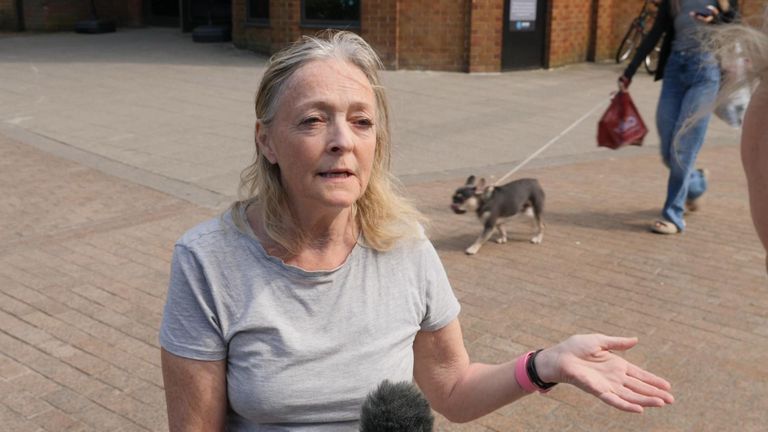Net migration rises to new record calendar year figure of 606,000 in the 12 months to December 2022
The figures show the difference between the number of people arriving and leaving the UK. The Office for National Statistics said that despite the rise in immigration last year, its estimates for long-term migration "suggest a slowing in growth over the most recent quarters".

Net migration rose to 606,000 in the year to December 2022, official statistics show.
The figure is the highest on record for a calendar year.
It comes despite a Tory 2019 manifesto commitment to "bring overall numbers down". The figure was 488,000 in 2021.
Net migration is the annual number of people arriving in the UK when both immigration and emigration are taken into account.
The figures, published by the Office for National Statistics (ONS) this morning, show that total long-term immigration was estimated at around 1.2 million in 2022, while emigration was 557,000.
Most people arriving in the UK last year were non-EU nationals (925,000), followed by EU (151,000) and British (88,000), the ONS said.
However, the ONS said that despite the rise in immigration last year, its long-term international migration estimates "suggest a slowing in growth over the most recent quarters".
Record-breaking net migration to 'ignite debate' over government action - politics latest
"This may reflect the temporary nature of these world events, as well as beginning to see higher numbers of international students emigrate. We will continue to monitor these patterns in the coming months," it said.
The body said it was a "unique year" for migration due to "world events" including the war in Ukraine and unrest in Hong Kong.
Today's net migration figure was calculated using new collection and counting methods for the first time. The ONS revised its previous figure - for the year to June 2022 - up from 504,000 to 606,000 - the same as today's new figure for the year to December 2022.
Immigration minister Robert Jenrick later confirmed that more than 200,000 Ukrainians and 150,000 Hong Kong British Nationals Overseas had come to the UK as part of bespoke schemes.
Mr Jenrick - who responded to an urgent question in the Commons today instead of Suella Braverman, the home secretary - said the statistics showed net migration had in fact "flatlined" since June 2022.
He also said the government expected net migration to return to pre-pandemic levels in the "medium term".
"The government remains committed to reducing overall net migration to sustainable levels," he said.
"That is a solemn promise we made to the British public in our manifesto, and we are unwavering in our determination to deliver it."
Jay Lindop, the director of the centre for international migration at the ONS, said numbers arriving on humanitarian routes increased over the 12-month period.
"The main drivers of the increase were people coming to the UK from non-EU countries for work, study and for humanitarian purposes, including those arriving from Ukraine and Hong Kong," she said.
"For the first time since using our new methods to measure migration, we have also included asylum seekers in our estimates, with around 1 in 12 non-EU migrants coming via this route.
"There are some signs that the underlying drivers behind these high levels of migration are changing. As lockdown restrictions were lifted in 2021, we saw a sharp increase in students arriving.
"Recent data suggests that those arriving in 2021 are now leaving the country, with the overall share of non-EU immigration for students falling in 2022.
"In contrast, those arriving on humanitarian routes increased over the 12 months. Evidence also suggests immigration has slowed in recent months, potentially demonstrating the temporary nature of these events."
Home Office figures released today also show that the backlog of asylum cases in the UK has hit a new record high, with a total of 172,758 people waiting for an initial decision on an asylum application at the end of March 2023 - up 57% compared to the same period last year.
It represents the highest figure since current records began in 2010.
The number of people waiting more than six months for an initial decision also stood at 128,812 at the end of March, up 76% year on year from 73,207 and another record high.
Sunak faces growing pressure from Tory ranks
The fresh statistics are likely to draw the ire of Tory backbenchers who want to see immigration reduced.
Prime Minister Rishi Sunak is under pressure after he appeared to back away from a commitment made under his predecessor, Boris Johnson, that net migration would fall below 250,000.
There will be a small sigh of relief in Number 10 today, that predictions that net migration would be north of 700,000, even one million, did not come to pass.
Even so, the headline figure sends a clear message. The government wants to cut migration but the numbers are plainly going in the opposite direction: net migration has hit a record level of 606,000.
In recent years several factors have come together at once: a boom in the recruitment of international students, skilled workers coming from outside the EU post-Brexit and schemes helping those coming from Ukraine and Hong Kong.
Whatever the complexities behind the rising figures, and even if they were not as high as expected, record net migration will fuel the right of the Conservative party and re-ignite a migration debate. There will be questions about whether the government’s rhetoric matches its action.
The prime minister knows on legal migration there is a balance to be struck with economic concerns over workforce shortages, a view expressed by the chancellor.
Former cabinet minister Robert Buckland told Kay Burley this morning a “more measured and calm debate” about migration is needed.
The home secretary, however, takes a tougher stance and behind the scenes it has even been suggested to me backlash to today's figures could help her cause in cabinet.
Whatever tensions might exist out of view, the government will struggle to detach itself from today’s record net migration figures, and to explain why, despite years pledging to bring the numbers down, the figures are still going in the opposite direction.
Shortly after the figures were released, Mr Sunak appeared on ITV's This Morning where he said that immigration was "far too high" but denied it was "out of control", arguing that "various factors" such as arrivals from Hong Kong and Ukraine have fuelled high rates.
He also pointed to new curbs on international students announced by the home secretary, Suella Braverman, that will end their right to bring family members to the UK unless they are on postgraduate courses that are currently designated as research programmes.
'What is the point of her?'
Labour said the figures were "extraordinary" and showed that the government has "no plan and no grip on immigration".
Shadow Home Secretary Yvette Cooper said work visas were up "119%" since the COVID pandemic and that the asylum backlog was also at a record high.
Querying the absence of Ms Braverman in the Commons, Ms Cooper asked: "Where is the home secretary who is in charge of these policies?
"What is the point of her?"
Migration Watch UK, which campaigns for lower immigration, was also unimpressed with the new figures.
The group said: "Immigration has already increased the UK population by nearly seven million over the past 20 years - that is seven times the population of Birmingham.
"As a result, a new home is already needed every five minutes, day and night, just for new arrivals, adding hugely to our housing problems and pressure on our services, GP surgeries and schools.
"Today's astounding figures mean even more homes, more doctors and more schools will be needed."
But Marley Morris, associate director for migration, trade and communities at the IPPR thinktank, said that while the net migration numbers were "high", there are "clear signs they are now stabilising".
"The government should beware kneejerk reactions to these figures, given they reflect a unique set of circumstances, including a series of humanitarian crises and the aftermath of the COVID-19 pandemic.
"Moreover, there is strong public support for the main drivers of net migration, including recruitment into the NHS, international students, and humanitarian routes. "
-sky news







